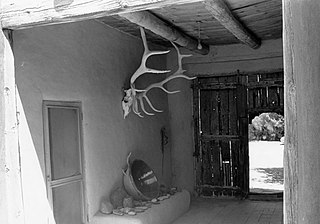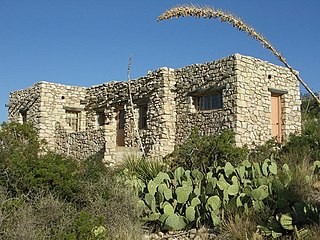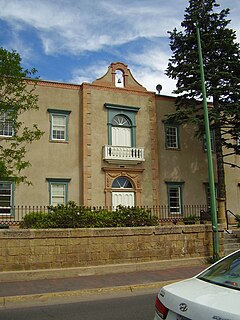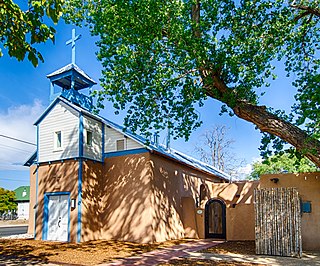
The Los Alamos Ranch House is a historic adobe house near Los Alamos in northern Santa Barbara County, California. The house, the centerpiece of Rancho Los Alamos, was built about 1840, and is one of the best-preserved examples of domestic architecture from California's Mexican period. The building was designated a National Historic Landmark in 1970.

The Juan de Anza House, also known as the Casa de Anza, is a historic adobe house in San Juan Bautista, California. Built around 1830, Casa de Anza is a well-preserved example of residential construction from the period of Mexican California. It was declared a National Historic Landmark in 1970.

Rancho Guajome Adobe is a historic 19th-century hacienda in Rancho Guajome Adobe County Park, on North Santa Fe Avenue in Vista, San Diego County, California. Built in 1852–53, it is a well-preserved but late example of Spanish-Mexican colonial architecture, and was designated a National Historic Landmark in 1970. It is also a California Historical Landmark and on the National Register of Historic Places.

The Georgia O'Keeffe Home and Studio is a historic house museum in Abiquiú, New Mexico. From 1943 until her death, it was the principal residence and studio of artist Georgia O'Keeffe (1887–1986). It is now part of the Georgia O'Keeffe Museum, which has sites in Santa Fe and Abiquiú. Public tours are available March–November, with advance tickets required. The Home and Studio became a National Historic Landmark in 1998, as one of the most important artistic sites in the southwestern United States.

The Hubert H. Bancroft Ranch House is a historic house museum at 9050 Memory Lane in Spring Valley, California. Built in 1856, it is the oldest Anglo-American building in the town. From 1885 until his death in 1918, it was home to Hubert Howe Bancroft, a pioneering historian of the western United States, Mexico, and Central America. Now managed by the local historical society as a museum, it was designated a National Historic Landmark in 1962 for its association with Bancroft, and was registered as a California Historical Landmark in 1958.

Seton Village is a National Historic Landmark District in a rural residential area south of Santa Fe in Santa Fe County, New Mexico, United States. It encompasses a residential settlement and educational facility established in 1930 by Ernest Thompson Seton (1860-1946), an educator and conservationist best known as a founder of the Boy Scouts of America. The district includes the remains of Seton's 32-room home and other residential and educational buildings constructed mostly between 1930 and 1945. It was declared a National Historic Landmark in 1965.

The Caverns Historic District comprises the central developed area of Carlsbad Caverns National Park. The complex was built between the early 1920s and 1942, initially in Pueblo Revival style, and later in New Mexico Territorial Revival style in the area around the natural entrance to Carlsbad Caverns. The earlier structures are built of local limestone, the later buildings in adobe. Thirteen buildings in the district are considered contributing structures. Buildings built between 1940 and 1942 were constructed with labor provided by the Civilian Conservation Corps.

The Lamy Building, also known as St. Michael's Dormitory, is a historic building in Santa Fe, New Mexico. It was built in 1878 as the main building of St. Michael's College, the predecessor of St. Michael's High School and the College of Santa Fe. The building is a contributing property in the Barrio De Analco Historic District and currently serves as the headquarters of the New Mexico Tourism Department.

The Salvador Armijo House is a historic hacienda in the Old Town neighborhood of Albuquerque, New Mexico. It was originally built in the 1840s by Salvador Armijo (1823–1879), a prosperous merchant who was the nephew of Governor Manuel Armijo. The house remained in the Armijo family for five generations and was remodeled or expanded several times, most notably in the 1870s and the early 1900s. Armijo's great-granddaughter Soledad C. Chacón, the future New Mexico Secretary of State, was a resident there in the early 1900s. During the mid-20th century, much of the building was converted into apartments. In 1977, Armijo's great-great-granddaughter Frances Wilson sold the house and it was turned into a restaurant, named Maria Theresa after the well-known silver coin. The restaurant closed in 2004. In 2009, the building was purchased by the adjoining Hotel Albuquerque and turned into a party and reception venue. It was listed on the New Mexico State Register of Cultural Properties in 1975 and the National Register of Historic Places in 1976.

The Los Candelarias Chapel, also known as the San Antonio Chapel, is a historic building in Albuquerque, New Mexico. The chapel was built in 1888 to serve the community of Los Candelarias, one of several outlying plazas spread along the Rio Grande in the vicinity of the main plaza at Old Town Albuquerque. It is one of the only surviving buildings from the no-longer-extant plaza. The building remained in use as a chapel until the 1950s and was subsequently converted into an artist's studio and then a private residence. It was listed on the New Mexico State Register of Cultural Properties in 1983 and the National Register of Historic Places in 1984.

San Jose de los Duranes Chapel is a historic building in Albuquerque, New Mexico. The chapel was built around 1890 to serve the community of Los Duranes, one of several outlying plazas spread along the Rio Grande in the vicinity of the main plaza at Old Town Albuquerque. The chapel was replaced with a new, larger San Jose Church in the 1960s, and fell into disrepair. In 1982–4, community members undertook a restoration of the building, replacing damaged or missing pews, rails, and doors, plastering the walls, repairing holes, and reinstalling the original religious artwork including paintings of the Crucifixion and a santo depicting St. Joseph. It was listed on the New Mexico State Register of Cultural Properties in 1983 and the National Register of Historic Places in 1984.

Los Tomases Chapel is a historic building in Albuquerque, New Mexico. The chapel was built in the 1920s to serve the late-19th-century North Valley neighborhood of Los Tomases, and remained in occasional use in the 1980s. It was listed on the New Mexico State Register of Cultural Properties in 1983 and the National Register of Historic Places in 1984.
The San Juan Historic District in San Juan, New Mexico is a 23 acres (9.3 ha) historic district which was listed on the National Register of Historic Places in 1988. The listing included 14 contributing buildings and two non-contributing buildings.

The Cayetano Juárez Adobe, often called locally the Old Adobe, is the oldest building in Napa, California. Built in 1845 by early Californio settler Cayetano Juárez, the structure was originally a family house and was later converted to a restaurant and bar. After an ownership change in 2014, it underwent an extensive restoration which was completed in 2019. The building was added to the National Register of Historic Places in 2015. It is currently the home of a Mexican restaurant.

The Antonio Vigil House is a historic building in the Old Town neighborhood of Albuquerque, New Mexico. It was built in 1879 as a rental property by Santiago Baca, a wealthy landowner who moved with his family to Albuquerque from Pecos, New Mexico in 1874. The home's original occupant was Albert Grunsfeld, a German Jewish merchant for whom Albuquerque's oldest Jewish congregation, Congregation Albert, is named. The Baca family sold the house in 1900, and after two changes of ownership, it ended up in the hands of Pilar Vigil in 1904. Her son Antonio Vigil lived there from 1922 to 1961 and the Vigil family continued to own the property at least into the 1970s. At some point the building was converted to commercial use. It was added to the New Mexico State Register of Cultural Properties in 1976 and the National Register of Historic Places in 1978.

The Delfina Gurule House is a historic house in Albuquerque, New Mexico. It was built by Delfina Gurule (1883–1979), who bought the lot in 1912 from Dolores Otero Burg, the daughter of former Congressional delegate Mariano S. Otero. The house was probably built shortly afterward, and Gurule lived there until her death in 1979. The building was added to the New Mexico State Register of Cultural Properties in 1979 and the National Register of Historic Places in 1980.

The Hilario Lopez House is a historic house in Albuquerque, New Mexico. It was built around 1907 by Hilario Lopez, who worked as a carpenter for the Atchison, Topeka and Santa Fe Railway. The house was added to the New Mexico State Register of Cultural Properties in 1979 and the National Register of Historic Places in 1980.

The Juan de Dios Chavez House is a historic house in Albuquerque, New Mexico. The date of construction is unknown but it was probably built sometime before 1875. The property was part of the land on which Juan Cristobal Armijo built his "New Homestead" around that time, and the Juan de Dios Chavez House is thought to be older based on its architecture. Juan de Dios Chavez, who belonged to an old North Valley family, acquired the house in the early 20th century. The house was added to the New Mexico State Register of Cultural Properties in 1983 and the National Register of Historic Places in 1984.

The Adrian Barela House is a historic house in Los Ranchos de Albuquerque, New Mexico. It was built around 1900, probably by Adrian Barela and his wife Jesusita Tenorio, who lived there until the early 1930s. The building was added to the New Mexico State Register of Cultural Properties in 1983 and the National Register of Historic Places in 1984. It is located on the same block as another historic property, the Refugio Gomez House.

The Felipe Romero House is a historic farmhouse in Albuquerque, New Mexico. It was probably built around 1900, and was expanded to its present size around 1904 by Felipe Romero. Romero, who came from an old New Mexico family, bought the property after his house lower in the Rio Grande valley was destroyed by a flood in 1903. The building was added to the New Mexico State Register of Cultural Properties in 1983 and the National Register of Historic Places in 1984.




















